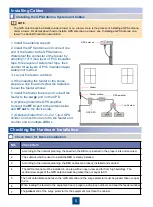
5
e
Installing Cables
1. Install the antenna support.
2. Install the GPS antenna and connect one
end of the feeder to the GPS antenna.
Waterproof the connector of the feeder by
adopting 1+3+3 (one layer of PVC insulation
tape, three layers of waterproof tape, then
another three layers of PVC insulation tape)
waterproof method.
3. Lay out the feeder outdoors.
4. When leading the feeder to the house,
prepare a drip loop and screw the fasteners
to seal the feeder window.
5. Install the feeder indoors and connect the
feeder to the
surge
port on the SPD.
6. (Optional) Install the GPS amplifier.
Connect the
RF in
port to the antenna side
and
RF out
to the device side.
7. (Optional) Install the 1-to-2 or 1-to-4 GPS
divider. Connect its one end to the feeder and
another end to multiple eBBUs.
Installing the GPS Antenna System and Cables
f
Checking the Hardware Installation
a
NO.
Check Item
1
According to the network planning, the boards in the BBU are inserted in the proper slots and secured.
2
The subrack which is used to install the BBU is steady installed.
3
According to the network planning, the BBU cables are properly installed and secured.
4
The GPS antenna must be installed in an area with an open view and far from high buildings. The
vertical view angle of the GPS antenna must be greater than or equal to 90
°
.
5
The horizontal distance between the GPS antenna and the surge protector must be greater than or equal
to 2 m.
6
When leading the feeder to the equipment room, prepare a drip loop outdoors and seal the feeder window.
7
The
protect
end of the surge protector for the equipment must face the cabinet.
Check Items for Device Installation
a
GPS antenna
Feeder
Feeder window
GPS amplifier
GPS SPD
1-to-2 divider
The GPS antenna can be installed under a tower or on a tower. Here is the process of installing a GPS antenna
under a tower. For details about how to install a GPS antenna on a tower,
see “Installing a GPS Antenna on a
tower” in
eNodeB Product Documentation.
NOTE

























